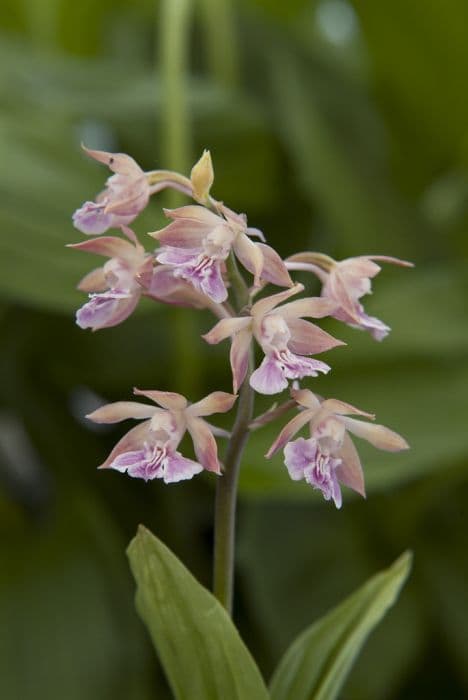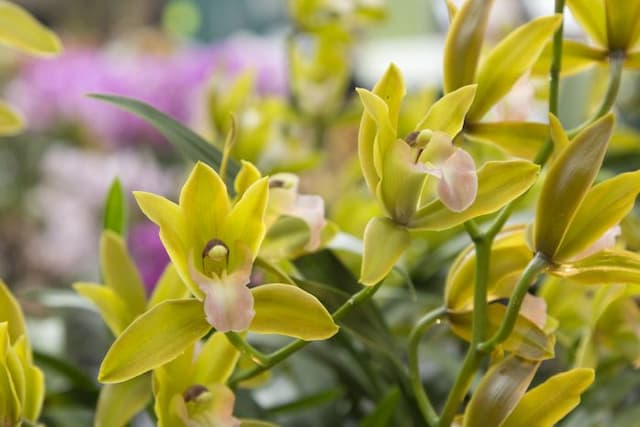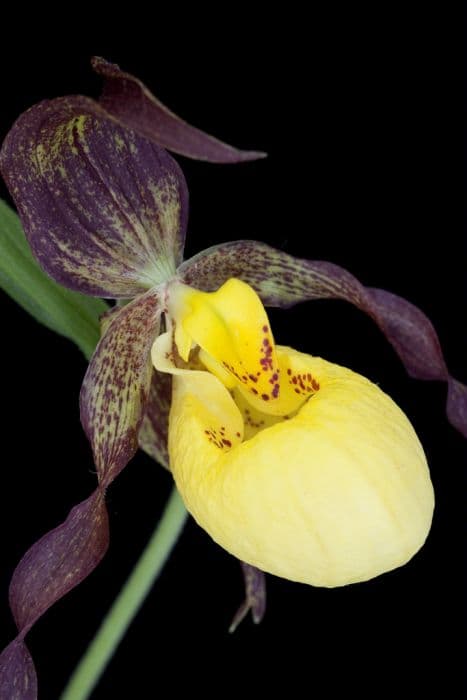Pinocchio Orchid Paphiopedilum Pinocchio gx

ABOUT
The Paphiopedilum Pinocchio, often referred to as the "Pinocchio orchid," is a distinctive and elegant plant recognized for its unique floral structure and attractive foliage. This orchid boasts a captivating flower that is shaped like a slipper, a characteristic feature of the lady's slipper orchid group to which it belongs. The blooms are long-lasting and display a harmonious blend of colors, typically showcasing a backdrop of a light green or yellowish-green petal and sepals, with some plants exhibiting a slight maroon or brown mottling. The most striking part of the Pinocchio orchid's flower is its dorsal sepal, which elegantly arches over the rest of the bloom. This sepal often presents a color contrast, adorned with deep spots or stripes that can range from burgundy to almost black. The flower's lip, shaped like an inflatable pouch and resembling a lady's slipper, is often a vibrant, glossy hue that can vary from pale green to darker shades of green or maroon, sometimes punctuated by intricate veining or speckling. Adding to the visual appeal, the Pinocchio orchid emits a long, slender inflorescence that holds the flower above the foliage. This flower spike can produce sequential blooms over time, lending the plant a prolonged and dynamic display. The glossy, broad leaves of the orchid grow in a low, mounded rosette, providing a lush backdrop that brings attention to the unusual beauty of the blossoms. Though compact and manageable as a cultivated plant, the Pinocchio orchid's visual impact is striking. Enthusiasts value this hybrid orchid for its charismatic flowers and relative ease of care, making it a popular choice for growers and a fascinating specimen in any collection of ornamental plants.
About this plant
 Names
NamesSynonyms
Pinocchio Orchid, Slipper Orchid.
Common names
Paphiopedilum Pinocchio gx.
 Toxicity
ToxicityTo humans
The Paphiopedilum species, commonly known as the "slipper orchid," is not considered toxic to humans. Therefore, ingestion of parts of the Paphiopedilum Pinocchio gx, a hybrid within the Paphiopedilum genus, would not typically result in poisoning or adverse health effects. However, it is generally recommended not to eat ornamental plants due to potential risks associated with non-food plants.
To pets
The Paphiopedilum, or "slipper orchid," is not known to be toxic to pets. Consuming parts of the Paphiopedilum Pinocchio gx should not cause poisoning or serious health issues in pets. Still, it is always best to prevent pets from ingesting plants, as individual animals might have sensitivity or allergic reactions, and non-food items can sometimes cause gastrointestinal upset.
 Characteristics
CharacteristicsLife cycle
Perennials
Foliage type
Evergreen
Color of leaves
Green
Flower color
Green
Height
1 foot (30 cm)
Spread
1 foot (30 cm)
Plant type
Herb
Hardiness zones
11
Native area
Asia
Benefits
 General Benefits
General Benefits- Ornamental Appeal: Adds aesthetic value to living spaces with its unique and striking flowers.
- Emotional Wellbeing: Improves mood and reduces stress by providing a sense of caring for a living thing.
- Hobby Interest: Cultivating Paphiopedilum Pinocchio, commonly known as Lady Slipper Orchid, can become a rewarding hobby.
- Educational: Growing the orchid can teach about plant care and botany.
- Enhances Environment: Adds a natural element and beauty to home or office environments.
 Medical Properties
Medical PropertiesThis plant is not used for medical purposes.
 Air-purifying Qualities
Air-purifying QualitiesThis plant is not specifically known for air purifying qualities.
 Other Uses
Other Uses- This orchid can be utilized as a living art piece in a terrarium, offering aesthetic enhancement through its unique flower structure and coloration.
- Paphiopedilum Pinocchio can be used as a biological indicator for monitoring environmental changes, as orchids are sensitive to alterations in their ecosystems.
- The plant's distinctive morphology can inspire artists and designers in creating jewelry, such as brooches or pendants that mimic its intriguing form.
- It can serve as a natural humidifier in small spaces, releasing moisture through transpiration.
- In educational settings, this orchid provides a hands-on learning opportunity for students studying botany and plant reproduction.
- Due to its rarity and unique appearance, Paphiopedilum Pinocchio can be used as a high-value collectible item for orchid enthusiasts.
- As a subject in photography, the orchid's intricate patterns and textures make for captivating close-up shots.
- The plant can be incorporated into eco-friendly wedding décor, representing a commitment to sustainability and natural beauty.
- It may be utilized in sensory gardens, as the tactile and visual stimuli of the flower can provide a therapeutic experience.
- When used in a feng shui arrangement, the orchid is believed to bring good luck and positive energy to a living space.
Interesting Facts
 Feng Shui
Feng ShuiThe Paphiopedilum, commonly known as the "Lady Slipper Orchid," is not specifically used in Feng Shui practice.
 Zodiac Sign Compitability
Zodiac Sign CompitabilityThe Lady Slipper Orchid is not used in astrology practice.
 Plant Symbolism
Plant Symbolism- Rarity: As Paphiopedilum Pinocchio gx is a hybrid orchid, it symbolizes uniqueness and rarity, reflecting the special care required to cultivate and maintain it.
 Water
WaterThe Paphiopedilum Pinocchio, commonly known as the Pinocchio orchid, requires consistent moisture and should be watered every 5 to 7 days, depending on environmental conditions. Use room temperature water and water the plant thoroughly until water runs freely from the drainage holes. This usually means approximately one eighth to one quarter of a gallon every week for a standard-sized pot. Do not allow the potting medium to completely dry out, but allow the top inch of the medium to become slightly dry to the touch before watering again.
 Light
LightThe Pinocchio orchid thrives in moderate light conditions without direct sunlight. The plant should be placed in an east-facing window or a shaded south- or west-facing window. Ensure it receives bright, diffused light to encourage healthy growth without the risk of leaf burn.
 Temperature
TemperatureThe Pinocchio orchid prefers temperatures between 50-70 degrees Fahrenheit at night and 70-80 degrees Fahrenheit during the day. They can tolerate a maximum temperature of about 85 degrees Fahrenheit and a minimum of 40 degrees Fahrenheit but will not survive extreme temperatures outside of this range. Maintaining a stable temperature within these parameters is ideal for the health of the plant.
 Pruning
PruningPruning of the Pinocchio orchid is generally done to remove dead or yellowing leaves and spent flower spikes to promote healthy growth and improve air circulation. Use sterilized cutting tools and prune as needed, typically after the plant finishes blooming. The best time to prune is usually in the late spring or early summer.
 Cleaning
CleaningAs needed
 Soil
SoilThe best soil mix for the Paphiopedilum, also commonly known as the 'Lady Slipper Orchid', should provide excellent drainage and aeration, resembling the plant's natural epiphytic growing conditions. A recommended mix could include equal parts of fine-grade fir bark or pine bark, perlite, and sphagnum moss. The ideal soil pH for Lady Slipper Orchids typically ranges from 5.5 to 6.5, slightly acidic.
 Repotting
RepottingLady Slipper Orchids, or Paphiopedilum Pinocchio gx, should be repotted once every one to two years. The best time to repot is right after flowering, or when new growth appears. Frequent repotting is unnecessary and can disturb the plant's growth unless the potting medium breaks down and impairs drainage.
 Humidity & Misting
Humidity & MistingLady Slipper Orchids thrive in moderate to high humidity levels, ideally between 40% to 70%. If grown in home environments, maintaining this humidity range can be crucial for the plant's health, and may require the use of a humidity tray or a room humidifier to achieve consistent conditions.
 Suitable locations
Suitable locationsIndoor
Provide bright, indirect light; maintain high humidity and warm temperatures.
Outdoor
Shelter from direct sun, protect from cold, maintain high humidity, water well.
Hardiness zone
10-12 USDA
 Life cycle
Life cyclePaphiopedilum Pinocchio, commonly referred to as the "Pinocchio Orchid," begins its life cycle as a seed, which typically requires symbiosis with a mycorrhizal fungus to germinate—a process that can take several months to years. After germination, the plant develops into a protocorm, an intermediary stage between a seed and a true seedling, which goes on to form leaves and roots as it matures into a seedling. As the seedling grows, it gradually forms a rosette of mottled leaves, characteristic of the genus Paphiopedilum. Once the plant reaches maturity, which can take several years, it produces a singular flower stem bearing a sequential bloom, where flowers develop one after another at the tip as the spike grows. With proper care, this flowering stage can continue for many months, as the "Pinocchio Orchid" is known for its long-lasting flowers. After flowering, the plant enters a period of vegetative growth, where it may also produce offshoots or 'keikis' that can be separated to form new plants, thus perpetuating its life cycle.
 Propogation
PropogationPropogation time
Spring to Summer
The most popular method for propagating the Paphiopedilum Pinocchio, commonly known as the Pinocchio orchid, is through division. This is typically best done in the spring, as the plant emerges from its winter rest period and begins a new growth cycle. To propagate by division, carefully remove the orchid from its pot and gently separate the pseudobulbs, making sure that each division has at least two or three growths or shoots. These divisions can be repotted into fresh orchid medium, ensuring that they are not planted too deeply to prevent rot. It is important to maintain high humidity and moderate light for the newly potted divisions to encourage root development. After care is crucial, with careful watering to keep the media slightly moist but not saturated, which will promote healthy growth in the severed divisions.









